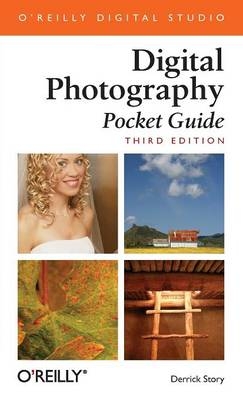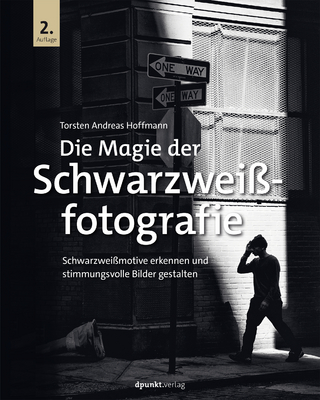
Digital Photography Pocket Guide
O'Reilly Media (Verlag)
978-0-596-10015-5 (ISBN)
Even film diehards have a tough time resisting the instant gratification of the digital camera. Today's digital cameras are more affordable then ever before, and they deliver high quality images that are a snap to share. Plus, you can take risks with a digital camera you never would with a film camera. You waste nothing; there's no film required, and because you only print the pictures you need, digital photography is cost effective and environmentally friendly. But to take full advantage of a digital camera, you need to be an experienced photographer and an expert at digital photography too. With more than 15 years of experience as a photojournalist, author Derrick Story brings you "Digital Photography Pocket Guide, 3rd Edition". For everyone who owns or will own a digital camera (and that pretty much means everyone!), this is the perfect on-the-go guide for taking top-notch digital photos. In this third edition of the bestselling pocket guide, Story expands on the basic photography techniques that he introduced in earlier editions, including an explanation of each camera component and what it does, tips for choosing just the right settings for your needs, and much more.
This indispensable guide covers everything from how to shoot sports action, close ups, and night shots, to dealing with image resolution, archiving, and memory cards. Affordable and portable, "Digital Photography Pocket Guide, 3rd Edition" offers full-color photographs, screen shots, and line art illustrating all the topics in the guide's three main sections ("Digital Camera Components," "Standard Camera Functions," and "How Do I?"). Contents are labeled A to Z for quick reference. There's also a comprehensive table of contents and index, so you'll waste no time flipping to the specific information you need. Whether you want to transfer images, make a QuickTime movie, or just figure out what purpose that mystery setting on your camera serves. There's even a section of easy-to-read reference tables for quick look-up of white balance settings, exposure. compensation, camera mode explanations, and plenty more.
Derrick Story is the managing editor of the O'Reilly Network, Mac DevCenter, and O'Reilly Digital Media. Derrick's experience includes more than 15 years as a photojournalist, a stint as the managing editor for Web Review, and a speaker for CMP, IDG, and O'Reilly conferences. He is the author of Digital Photography Hacks, Digital Photography Pocket Guide, 2nd Ed., and the PowerBook and iBook Fan Books. He coauthored iPhoto: The Missing Manual, which is now in its third edition. Derrick likes to keep his shooting skills sharp by running his photography business, Story Photography.
Chapter 1 Who's in Charge? 1. What Is It? Overview of Camera Categories Feature and Component Comparisons Anatomy of a Compact Camera Flash Focus assist light Microphone port Optical viewfinder lens Picture-taking lens Confirmation light Display control button LCD monitor Menu button Mode dial Multifunctional jog dial Set/OK button Trash button Computer connection Shutter button Tripod socket Video out connection Zoom/magnify lever Battery Direct Print Image sensor Memory card PictBridge RAM buffer USB Mass Storage Battery types Diopter adjustment Exposure metering options Hotshoe Image stabilizer Infrared sensor LCD viewfinders that swivel Memory card options Remote release Zoom lenses Professional Cameras Electronic flashes Image sensors Optics WiFi image transfer Hybrid Devices Cameraphones DV Camcorders That Capture Stills Still Cameras That Record High-Quality Movies Putting It All Together 2. What Does It Do? Digital Camera Controls A-Z Aperture Value (Av) Mode Autoexposure AVI Burst/Continuous Shooting Mode Close-ups Composition Compression and Image Quality Continuous Shooting Mode Deleting Images Digital Zoom DNG Erasing Images Exposure Compensation Exposure Lock Exposure Metering File Formats (Still Images) Film Speed Flash Compensation Flash Modes Focus Lock Format Card Infinity Lock ISO Speed JPEG Macro Mode Magnify Control Manual Exposure Mode Movie Mode MPEG-4 Movie Format Panorama Mode Partial Metering Area Photo Effects Programmed Autoexposure Protect Images RAW Resolution Self-Timer Sequence Shooting Shutter Priority Mode Spot Meter TIFF Timed Value (Tv) Mode White Balance Zoom/Magnify Control Putting It All Together 3. How Do I-? Shooting Tips and Tricks: How Do I- Take Great Outdoor Portraits Set Up Group Shots Capture Existing-Light Portraits Take Passport Photos and Self-Portraits Take Interesting Kid Shots Capture Engaging Travel Locations Take Pictures at Weddings Prevent Red Eye Take Pictures from the Stands at Sporting Events Capture Action Shots Shoot in Museums Shoot Architecture Like a Pro Shoot Items Using Tabletop Photography Create Powerful Landscape Images Shoot Infrared Images Take Flash Pictures of People Who Blink at Flash Computer Tips and Tricks: How Do I- Send Pictures via Email Share Pictures on the Web Get Photo-Quality Prints Present a Digital Slideshow Work with RAW Files Archive Images for Future Use Manage Movies Made with a Digital Camera Stitch Together Video Clips into Short Movies Where to Go from Here Appendix Index
| Erscheint lt. Verlag | 27.9.2005 |
|---|---|
| Verlagsort | Sebastopol |
| Sprache | englisch |
| Einbandart | kartoniert |
| Themenwelt | Kunst / Musik / Theater ► Fotokunst |
| Sachbuch/Ratgeber ► Freizeit / Hobby ► Fotografieren / Filmen | |
| Mathematik / Informatik ► Informatik ► Grafik / Design | |
| ISBN-10 | 0-596-10015-9 / 0596100159 |
| ISBN-13 | 978-0-596-10015-5 / 9780596100155 |
| Zustand | Neuware |
| Informationen gemäß Produktsicherheitsverordnung (GPSR) | |
| Haben Sie eine Frage zum Produkt? |
aus dem Bereich


